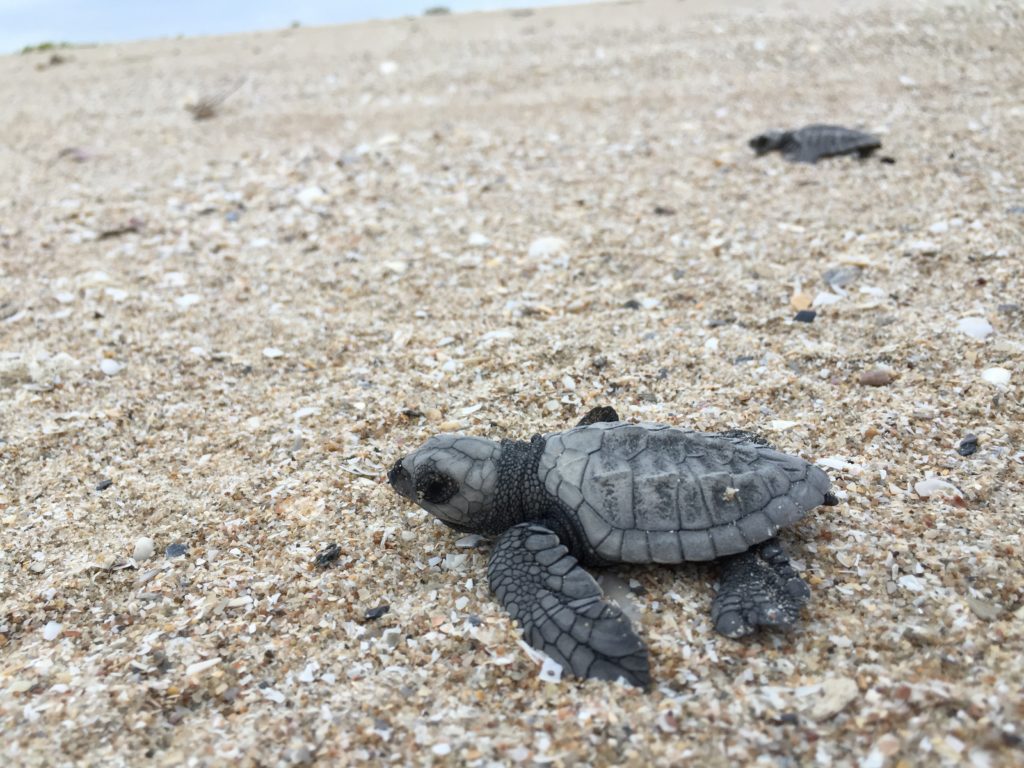
Baby turtles head across the sand to the sea (Image: APN Cape York archive)
Our researchers are working with Indigenous rangers in Cape York, Microsoft and the Australian Government to protect baby turtles now and into the future.
It’s late at night. An 80kg female flatback turtle is hauling herself up to the shore. She’s about to lay her eggs in the sands of a beach in western Cape York Peninsula, in north Queensland.
But trouble looms. Even after she covers the nest in sand, her tracks and the strong smell of freshly laid eggs will attract predators. Goannas and dingoes may eat some, but it’s feral pigs that are the biggest threat. In some parts of western Cape York, in far north Queensland, feral pigs can dig up and eat 100 per cent of turtle nest eggs.
We’re working with rangers from Aak Puul Ngantam (APN) Cape York, a not-for-profit organisation belonging to Southern Wik Traditional Owners, and Microsoft. It’s part of the Australian Government’s National Environmental Science Program (NESP). The partnership aims to look after baby turtles now and into the future.
To request a transcript please contact us.
Feral pigs spell danger for baby turtles
Turtle is one of many traditional food sources for local Traditional Owners, and they have always been consumed at a sustainable level. But pigs are a different story all together.
Since being introduced in the 1800s, feral pigs have exploded in number across northern Queensland. Ten years ago, APN rangers raised the alarm about the impact of pigs. There is a 50km stretch of beach where APN focuses their turtle protection work. Feral pigs can dig up and eat all of the turtle nest eggs in this area. That’s about 2000 turtles each year.
Dr Justin Perry is a Research Scientist, and our lead on this research partnership.
“Feral animals have a huge impact on biodiversity and culture on Cape York, especially on marine turtles,” Justin said.
Rangers are working hard to protect turtles from predation. The stakes are high. Of the seven species of sea turtle, six of them are listed as threatened with global extinction.
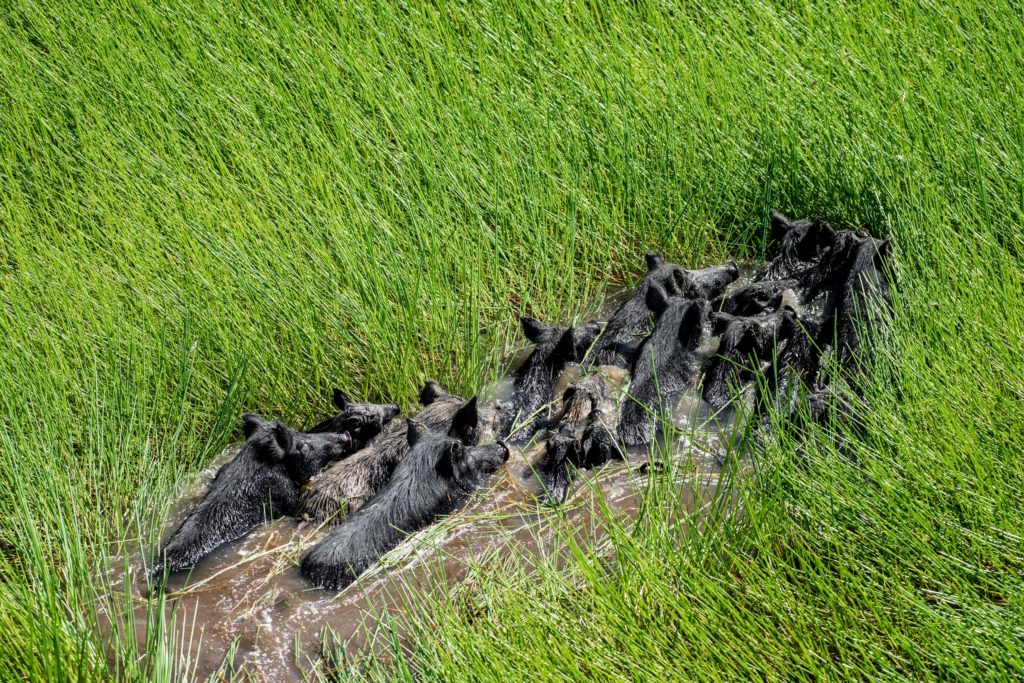
Feral pigs threaten native species and the environment (Brian Ross photo)
Turtles in the tropics: looking after endangered species
There are three types of turtles that nest on western Cape York beaches every year between June and November: Flatback turtles, Olive Ridleys and Hawksbills.
The rangers are focused on looking after Olive Ridley and the Flatback turtles. Flatback turtles, like our mother turtle from the beginning of this story, only live in the waters around Australia. Hawksbills are very rare on this coast. Justin reports they’ve only found about a dozen of these turtles, in total, since the team started monitoring in 2010.
But the biggest concern is the Olive Ridley turtles.
“Their nests are shallow and are generally laid on the beach rather than in the dune vegetation, so they’re very exposed. Before the rangers targeted predator management, 100 per cent of their nests surveyed on the accessible beach were destroyed, with the main culprit being feral pigs,” Justin said.
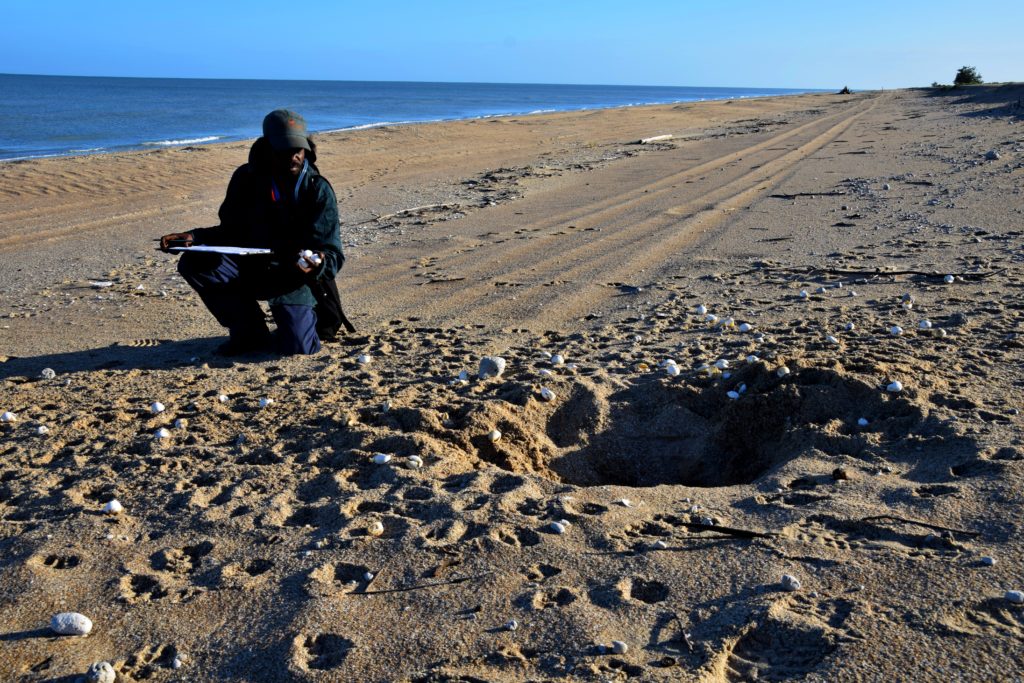
Rangers document each heartbreaking turtle nest loss (Image: Brian Ross)
Crossing crocodile-inhabited waters to care for turtles
A turtle’s nest is most vulnerable in the first few days after the eggs are laid. This is when the mother turtle’s tracks are still visible to predators and when the scent of the eggs is strongest. Then there is a 50-day wait until the hatchlings start to emerge.
To protect the turtles, rangers need to understand – almost in real-time – where turtles are laying their eggs, where the pigs are eating the nests, and when. If rangers can get fast access to this information (monitoring data) in the first few days, they can quickly decide where they will focus their pig-control efforts. Early efforts have been promising. The rangers’ work in controlling feral pigs has helped to reduce predation of turtle nests by as much as 90 per cent.
In the past, rangers have visited these remote beaches to record nest sites and predation. But it’s a huge logistical challenge just to access the beaches, especially with the wet season rains.
“It’s really, really hard work to get out on the beaches in western Cape York,” Justin said.
“We can only get to short sections of the beach to do monitoring, and only in a short window of time. Turtle-nesting beaches are on the other side of a 100-metre-wide floodplain. You can’t get across safely after the wet season. It’s waist-deep and there are crocodiles there!”

The country is beautiful, but inaccessible in the wet (Image: APN Cape York archive)
Often, by the time the rangers could reach the beach, many of the eggs had already been eaten. And even when they could access the beaches, the monitoring data collected took too long to process.
The rangers realised they needed a more immediate way to see where turtles were laying eggs, and where pigs were eating them.
Hatching a better plan for turtle hatchlings
Justin has been working with the local community since 2008 to improve management and monitoring.
“We built this from the ground up with rangers. It was an eight-year process before we started even thinking of technical solutions,” he said.
After working on the Kakadu wetland project, Justin turned to Microsoft for their help in ethical artificial intelligence and cloud computing platforms. Both of these collaborations are supported by the Australian Government through the NESP Northern Australia Environmental Resources Hub.
“The very clear feedback from the rangers was, ‘wouldn’t it be wonderful if we could get that [nest and pig track] information in real-time, so we could make decisions on the beach’,” Justin said.
With the system built by Microsoft, rangers can now remotely monitor beaches via aerial photography.
As Indigenous ranger Dion Koomeeta said: “We use science to protect the turtles so our next generation can know what the turtles look like.”
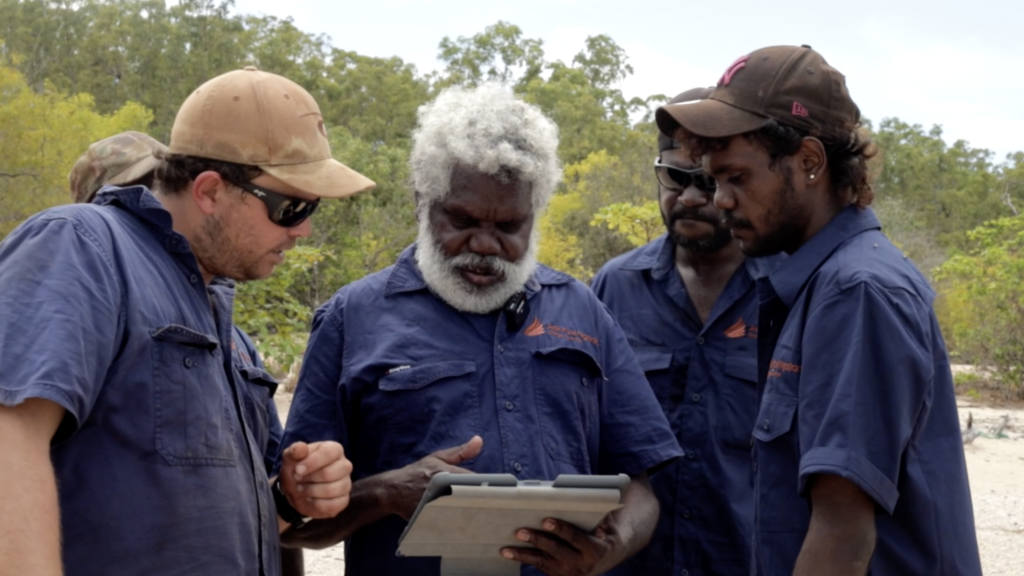
Real-time insights help APN Cape York rangers manage the region (Image: Phisch Creative)
How does the AI system work?
Steve Van Bodegraven is a machine learning engineer from Microsoft.
“When rangers get back to their station with their [aerial photograph] surveys, the drone images are uploaded to the cloud using Wi-Fi,” Steve said.
“Then they are automatically analysed. The models we’ve created sort the landscape and find the turtle nests, turtle tracks and pig tracks.”
The locations of the nests and tracks then show up on a digital dashboard. So the rangers know exactly where the nests are and where the pigs are. They can then focus their control work to where those new nests are.
“Partnering with Microsoft means we can use their AI and cloud computing to analyse tens of thousands of images taken from drones and helicopters,” Justin said.
What once took one month of difficult on-the-ground monitoring work can now be achieved in just two hours using a helicopter or drone, cloud computing and AI.
Using Indigenous knowledge and AI to save baby turtles
For Justin, one of the best parts of this work is that it can be used by others.
“The technology that we’re developing through NESP in partnership with Microsoft has the potential to be applied to turtle nesting sites all around the world,” he said.
“It means that rangers like the APN staff can focus on actual management work. And that’s where you get important conservation outcomes. The whole reason monitoring exists is to inform adaptive management. But often we spend lots of time doing the monitoring because it’s really hard work. So, then you can end up just documenting the demise of a species. But with this system, rangers have critical information when they need it. The good news story out of this research is that we can do something about it, and we have.”
And for our female flatback turtle laying her eggs, it means a better chance that her baby turtles will make it out to sea.
“The good news story out of this research is that we can do something about it, and we have,” he said.
In 2019, CSIRO worked with the Australian Government to release an AI Ethics Framework to provide ethical considerations around the design and application of AI.
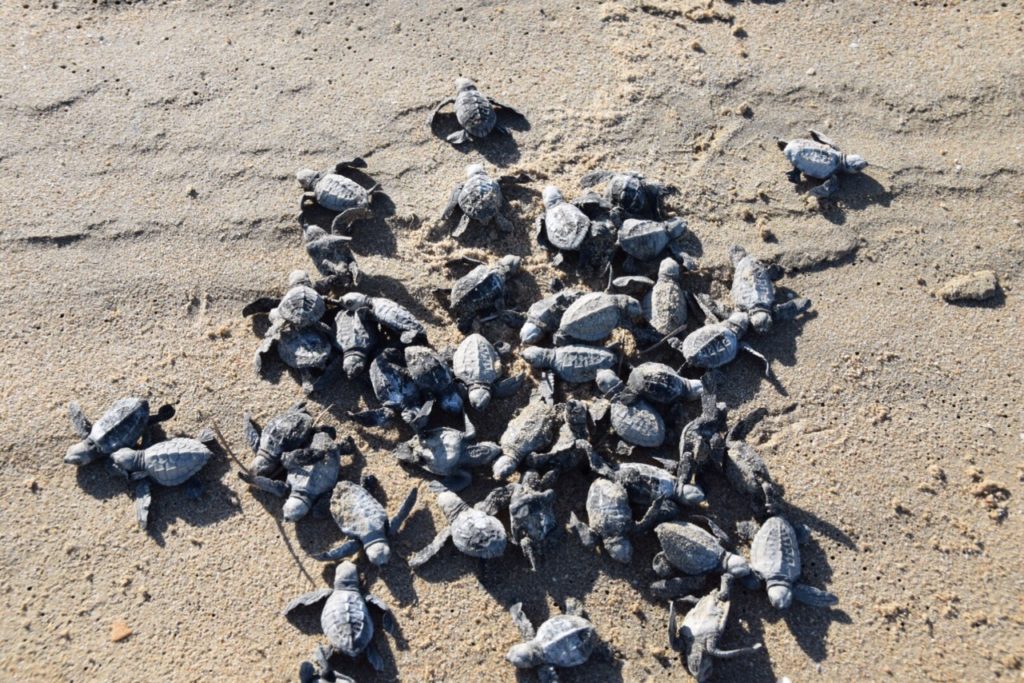
Hatchlings scramble for the sea (Image: APN Cape York)


28th May 2021 at 3:15 pm
This is fantastic work. But I still don’t know how you stop the feral pigs from eating the eggs. Can you explain what is involved in ‘the control work’?
19th February 2021 at 3:48 pm
I love that this is happening. The Save the Bilby fund is also using this technology to track feral foxes and cats near their bilby enclosures in remote south-western Qld and NT. https://savethebilbyfund.com/our-work/ We are currently working with them to showcase how they are using Digital Technologies to help save the bilby.